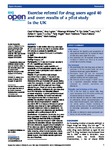Exercise referral for drug users aged 40 and over: results of a pilot study in the UK
| dc.contributor.author | Beynon, CM | |
| dc.contributor.author | Luxton, A | |
| dc.contributor.author | Whitaker, R | |
| dc.contributor.author | Cable, NT | |
| dc.contributor.author | Frith, L | |
| dc.contributor.author | Taylor, Adrian | |
| dc.contributor.author | Zou, L | |
| dc.contributor.author | Angell, P | |
| dc.contributor.author | Robinson, S | |
| dc.contributor.author | Holland, D | |
| dc.contributor.author | Holland, S | |
| dc.contributor.author | Gabbay, M | |
| dc.date.accessioned | 2019-05-07T15:00:13Z | |
| dc.date.available | 2019-05-07T15:00:13Z | |
| dc.date.issued | 2013 | |
| dc.identifier.issn | 2044-6055 | |
| dc.identifier.issn | 2044-6055 | |
| dc.identifier.other | ARTN e002619 | |
| dc.identifier.uri | http://hdl.handle.net/10026.1/13780 | |
| dc.description.abstract |
OBJECTIVES: To test whether older drug users (aged 40 and over) could be recruited to an exercise referral (ER) scheme, to evaluate the feasibility and acceptability and measure the impact of participation on health. DESIGN: Observational pilot. SETTING: Liverpool, UK. PARTICIPANTS: (1) 12 men and 5 women recruited to ER. (2) 7 specialist gym instructors. OUTCOME MEASURES: Logistic feasibility and acceptability of ER and associated research, rate of recruitment, level of participation over 8 weeks and changes in health. RESULTS: 22 gym inductions were arranged (recruitment time: 5 weeks), 17 inductions were completed and 14 participants began exercising. Attendance at the gym fluctuated with people missing weeks then re-engaging; in week 8, seven participants were in contact with the project and five of these attended the gym. Illness and caring responsibilities affected participation. Participants and gym instructors found the intervention and associated research processes acceptable. In general, participants enjoyed exercising and felt fitter, but would have welcomed more support and the offer of a wider range of activities. Non-significant reductions in blood pressure and heart rate and improvements in metabolic equivalents (METs; a measure of fitness) and general well-being were observed for eight participants who completed baseline and follow-up assessments. The number of weeks of gym attendance was significantly associated with a positive change in METs. CONCLUSIONS: It is feasible to recruit older drug users into a gym-based ER scheme, but multiple health and social challenges affect their ability to participate regularly. The observed changes in health measures, particularly the association between improvements in METs and attendance, suggest further investigation of ER for older drug users is worthwhile. Measures to improve the intervention and its evaluation include: better screening, refined inclusion/exclusion criteria, broader monitoring of physical activity levels, closer tailored support, more flexible exercise options and the use of incentives. | |
| dc.format.extent | e002619-e002619 | |
| dc.format.medium | Electronic | |
| dc.language | en | |
| dc.language.iso | eng | |
| dc.publisher | BMJ | |
| dc.subject | Health services administration & management | |
| dc.subject | Mental health | |
| dc.subject | Public health | |
| dc.title | Exercise referral for drug users aged 40 and over: results of a pilot study in the UK | |
| dc.type | journal-article | |
| dc.type | Journal Article | |
| plymouth.author-url | https://www.webofscience.com/api/gateway?GWVersion=2&SrcApp=PARTNER_APP&SrcAuth=LinksAMR&KeyUT=WOS:000330538300049&DestLinkType=FullRecord&DestApp=ALL_WOS&UsrCustomerID=11bb513d99f797142bcfeffcc58ea008 | |
| plymouth.issue | 5 | |
| plymouth.volume | 3 | |
| plymouth.publication-status | Published | |
| plymouth.journal | BMJ Open | |
| dc.identifier.doi | 10.1136/bmjopen-2013-002619 | |
| plymouth.organisational-group | /Plymouth | |
| plymouth.organisational-group | /Plymouth/Faculty of Health | |
| plymouth.organisational-group | /Plymouth/Faculty of Health/Peninsula Medical School | |
| plymouth.organisational-group | /Plymouth/REF 2021 Researchers by UoA | |
| plymouth.organisational-group | /Plymouth/REF 2021 Researchers by UoA/UoA03 Allied Health Professions, Dentistry, Nursing and Pharmacy | |
| plymouth.organisational-group | /Plymouth/Research Groups | |
| plymouth.organisational-group | /Plymouth/Research Groups/FoH - Community and Primary Care | |
| plymouth.organisational-group | /Plymouth/Research Groups/Institute of Health and Community | |
| plymouth.organisational-group | /Plymouth/Research Groups/Institute of Translational and Stratified Medicine (ITSMED) | |
| plymouth.organisational-group | /Plymouth/Research Groups/Institute of Translational and Stratified Medicine (ITSMED)/CCT&PS | |
| plymouth.organisational-group | /Plymouth/Research Groups/Plymouth Institute of Health and Care Research (PIHR) | |
| plymouth.organisational-group | /Plymouth/Users by role | |
| plymouth.organisational-group | /Plymouth/Users by role/Academics | |
| plymouth.organisational-group | /Plymouth/Users by role/Researchers in ResearchFish submission | |
| dc.publisher.place | England | |
| dc.identifier.eissn | 2044-6055 | |
| dc.rights.embargoperiod | Not known | |
| rioxxterms.versionofrecord | 10.1136/bmjopen-2013-002619 | |
| rioxxterms.licenseref.uri | http://www.rioxx.net/licenses/all-rights-reserved | |
| rioxxterms.type | Journal Article/Review |


